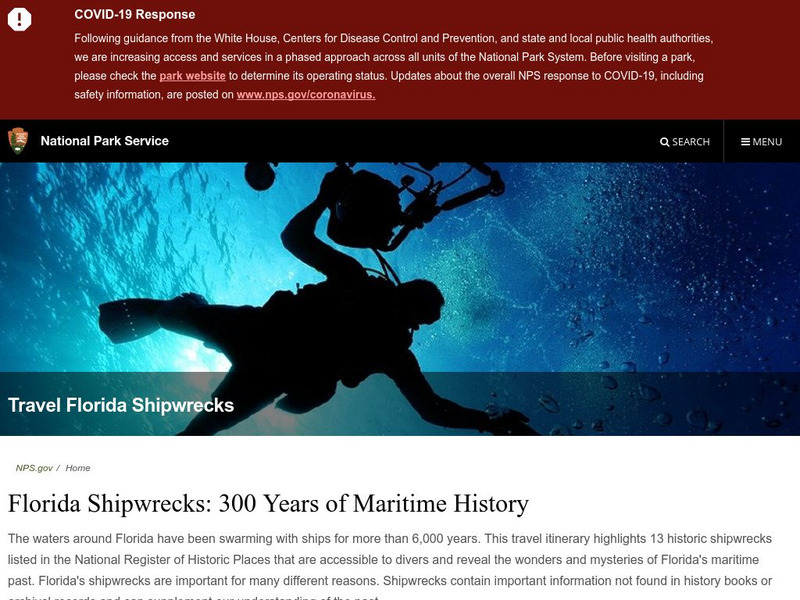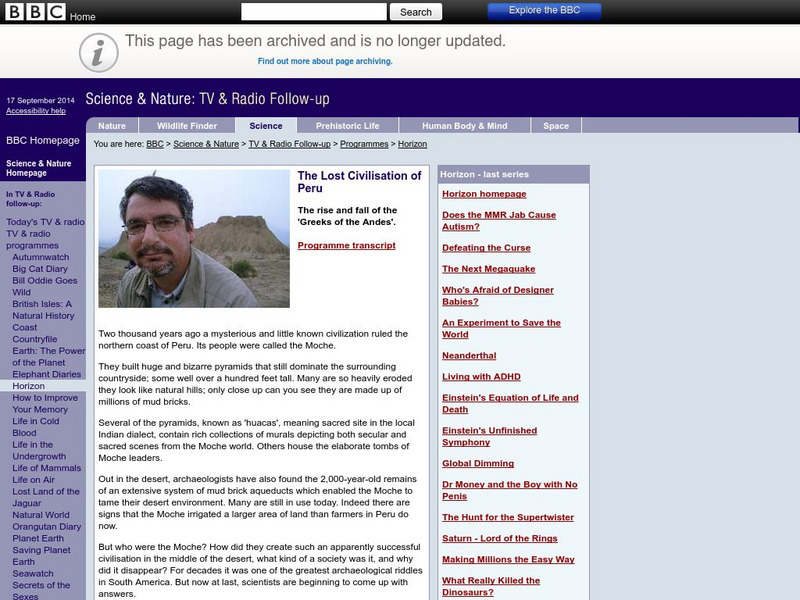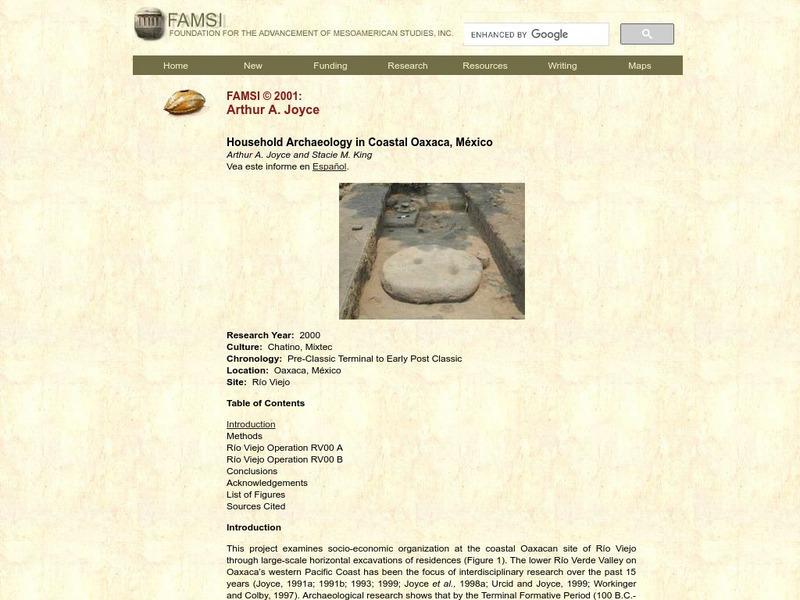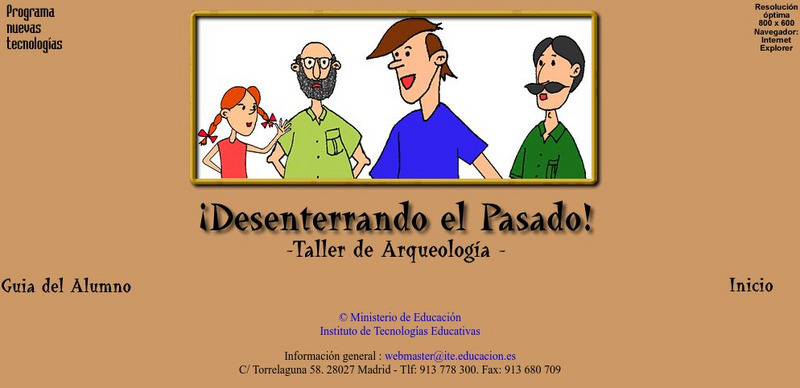American Museum of Natural History
American Museum of Natural History: Inca Investigation
Be an archaeologist and examine maps and ancient artifacts relating to the Inca empire.
Archaeological Institute of America
Archaeology: Neolithic Surgery
Summary of research on a 7,000 year old burial that shows evidence of successful brain surgery. Describes the type of surgery, what it was for and how the relics seem to show what was done.
Archaeological Institute of America
Archaeology: Riddle of Great Zimbabwe
Briefly explores the differing explanations for Great Zimbabwe's location and structures.
NBC
Archaeologists Identify Copernicus? Skull
Archaeologists believe that they have found the skull of Nicolaus Copernicus. A portrait is provided for how he was believed to have appeared and information is offered regarding how the procedure was conducted.
BBC
Bbc: History: Wetwang Chariot
See an animation of the archaeological dig at a burial site in Wetwang, England. After you see how the site was excavated, you can watch a detailed animation of the construction of a chariot similar to what was found at the site. Archived.
Curated OER
National Park Service: Florida's Shipwrecks: 300 Years of Maritime History
Explore the maritime history of Florida through its shipwrecks. Site includes list of shipwreck sites, maps of shipwrecks, and extensive history.
Adventure Learning Foundation
Adventure Learning Foundation: Peru Lesson Plans
The lesson plans included here are based on the information collected from a learning expedition to Peru. There are specific plans for geography and the environment, economy, history, archaeology and for creating a travel brochure....
BBC
Bbc: Moche
More than two thousand years ago the Moche, a successful civilization, ruled the northern coast of Peru. Find out about this little know civilization as archaeologists begin to uncover some of the answers. Archived.
Scholastic
Scholastic News: An Ancient Palace Uncovered
Archeologists in China discovered the ruins of an ancient palace build to honor China's first emperor. Learn more about this important structure, part of the massive burial complex of Emperor Qin Shihuangdi.
Scholastic
Scholastic News: Week of 4 15 13: Unearthing Ancient Africa
Qatar is providing significant financial assistance to Sudan in order for archeologists to have the fund they need to locate and preserve the grand pyramids in Sudan, some of which are 5,000 years old.
Read Works
Read Works: News Shorts: Tomb Raiders
[Free Registration/Login Required] An informational text about American archaeologists who discovered an Egyptian tomb. A question sheet is available to help students build skills in reading comprehension.
A&E Television
History.com: Ancient Egypt
For almost 30 centuries -- from its unification around 3100 B.C. to its conquest by Alexander the Great in 332 B.C. -- ancient Egypt was the preeminent civilization in the Mediterranean world. From the great pyramids of the Old Kingdom...
University of Illinois
University of Illinois: African American Archaeology Network: Archaeology of the Boston Saloon
Article provides a look at the Boston Saloon in Virginia City which catered to the African American residents of that mining city.
Foundation for the Advancement of Mesoamerican Studies
Famsi: Household Archaeology in Coastal Oaxaca, Mexico
Offers dimensions of Mixtec household and density of urban village. Household ritual included food processing, tool and textile production, and ceramic production using molds. The importance of Rio Viejo as an urban center is discussed.
Foundation for the Advancement of Mesoamerican Studies
Famsi: Palenque Hydro Archaeology Project (2005)
Study indicates that Palenque aquaducts were part of city planning and suggests reasons that Mayans would choose the existing plan. Many photographs of the aquaduct are included.
Foundation for the Advancement of Mesoamerican Studies
Famsi: Surface Archaeology in the Chilapa Zitiala Area (2003)
Study at the Chilapa-Zitlala, Mexico site indicates possibility of Olmec presence.
Other
Institute of Egyptian Art and Archaeology
Take a tour of Egypt or visit the online exhibit of artifacts at this site. Descriptions and history of the artifacts are given and there is an impressive links page.
Georgia Humanities Council and the University of Georgia Press.
New Georgia Encyclopedia: History and Archaeology: Battle of Chickamauga
Discover facts about the Battle of Chickamauga, which was fought in 1863 and was the biggest Civil War battle ever to take place in Georgia.
Georgia Humanities Council and the University of Georgia Press.
New Georgia Encyclopedia: History and Archaeology: Black Troops in Civil War Georgia
The New Georgia Encyclopedia provides an article describing the role, recruitment, and enlistment of black troops in Georgia during the Civil War.
Georgia Humanities Council and the University of Georgia Press.
New Georgia Encyclopedia: History and Archaeology: Andersonville Prison
Andersonville Prison was created in February, 1864 to relieve the overcrowding of Union prisoners in other nearby prisons. It closed a year later due to sanitation problems among others and had earned a reputation for inflicting...
Georgia Humanities Council and the University of Georgia Press.
New Georgia Encyclopedia: History and Archaeology: Indigo
Discussion of how production of the blue dye, indigo, helped boost the economy of Georgia and South Carolina in the seventeenth and eighteenth century until the Revolutionary War when England stopped buying it and production collapsed.
Georgia Humanities Council and the University of Georgia Press.
New Georgia Encyclopedia: History and Archaeology: Eli Whitney in Georgia
Although Eli Whitney was born in Massachusetts, it was in Georgia that he invented the cotton gin in 1793.
Ministerio de Educación (Spain)
Ministerio De Educacion: Desenterrando El Pasado!
On this site you can see, play and learn about the exciting world of archaeology.
Ministerio de Educación (Spain)
Ministerio De Educacion: Desenterrando El Pasado! Taller De Arqueologia
Play and learn about the exciting world of Archaeology.
Other popular searches
- Archaeology Math
- Archaeology Videos
- Art and Archaeology
- Science Archaeology
- Archaeology Recording Form
- Archaeology Internet
- Archaeology Animal
- Material Culture Archaeology
- Olympic Archaeology
- Music and Archaeology
- Archaeology of the Future
- Archaeology Alaska
























